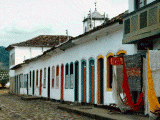
| Rio de Janeiro |

|


| Rio de Janeiro |

|

Rio de Janeiro, was discovered on January (Janeiro) 1, 1502 by Portuguese navigators who mistook the entrance of Guanabara Bay for the mouth of a river (Rio). Sixty years later because French traders in search of pau-brasil (Brazilwood) were routinely "visiting" the area the Portuguese crown established the city of Sao Sebastiao do Rio de Janeiro. After 2 years of bloody conflict the French were expelled and settlers began to cultivate the surrounding fertile lands. In the beginning of the 18th century the city's importance and population increased immensely as it became the main shipping port for gold and diamonds that came from Minas Gerais. In 1763 the colonial capital of Brazil was transfered from Salvador, Bahia to Rio. In 1808, as Napoleon's armies began the invasion of Portugal, the decision was made to transfer the monarch and his court to Rio de Janeiro, where he would remain until 1821. During this time Brasil was elevated in status from a colony to United Kingdom with Portugal. With the advent of Independence Rio became the capital of the new empire. The city prospered economically, and by 1891 it had a population of over 500,000 inhabitants ranking it one of the largest cities in the world. As the city grew in prominence mountains were removed, bay water reclaimed, and skyscrapers constructed.
With the inauguration of
Brasilia in 1960, Rio de Janeiro ceased to be Brazil's
capital. Even today
discussion is rife concerning whether Rio was improved or hurt by the
transfer of the
government. In any event, this second largest city in Brazil is still a
major cultural capital and,
to some extent, its "emotional" capital as well.
Rio de Janeiro has a majestic beauty, with built-up areas nestled between
a magnificent bay and
dazzling beaches on one side and an abruptly rising mountain range,
covered by a luxuriant
tropical forest, on the other. This unique landscape makes Rio one of the
most beautiful cities in
the world, justifying its title of "Marvelous City" (Cidade Maravilhosa).
Rio's cultural life is intense and varied. Perhaps at no time is the
city's festive reputation better displayed than
during the annual carnaval
which enlivens the city for 3 solid days with music,
singing, parties, balls, and desfiles (street parades of
brilliantly-costumed
dancers performing the
samba.)
Economically it is a service
industry center, a key
financial center, and the producer of foodstuffs, building materials,
electrical equipment,
chemicals, pharmaceuticals, beverages, and textiles. But it is in the
pursuit of leisure that Rio is
outstanding. With its world famous beaches free to all (such as
Copacabana and Ipanema), its
splendid bay, one of the loveliest in the world, and its wonderful
climate, a blend of summer
and springtime, Rio de Janeiro is a city that lives in and for the sun.
Its population is around
5,750,000 inhabitants.
(Portions adapted from the Brazilian Embassy in Washington,DC)
Encyclopedia Brittanica-Access may be limited.
Note: Not all gif files are currently operational.


 Scenic Views of Beaches & Mountains
Scenic Views of Beaches & Mountains
 Go Walking
gif
(62K)
or
jpeg (115K)
Go Walking
gif
(62K)
or
jpeg (115K)
 Markets
Markets
Top of Page * Choose Another Destination
 Tourist Information
Tourist Information
Top of Page * Choose Another Destination
Top of Page *
Choose Another
Destination
![]()

The State of Rio de Janeiro
Area : 44,268 sq.km.
Population : 12,775,000
Capital : Rio de
Janeiro


![]() Landmarks
Landmarks